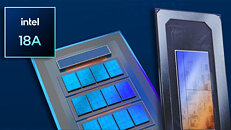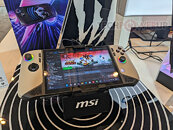T0@st
News Editor
- Joined
- Mar 7, 2023
- Messages
- 2,422 (3.40/day)
- Location
- South East, UK
In an exclusive report, Laptop Mag has extracted intriguing disclosures from Intel's Robert Hallock. The company's VP and General Manager of Client AI and Technical Marketing was happy to announce that new-generation processors are lined up for inclusion within next waves of handheld gaming PCs. Industry rumors posited that things would end with Team Blue's Core Ultra "Lunar Lake" generation of APUs; as featured on the recently deployed MSI Claw 8 AI+ and Claw 7 AI+ models. First-generation devices with "Meteor Lake" chips did not disrupt the market, and struggled to keep up with AMD Ryzen Z1 chipset-based rivals. Despite negative conjecture suggesting a withdrawal, Hallock revealed that a certain department is growing in size: "Intel is beefing up its staff to support gaming ISVs who want to do handhelds."
Team Blue's fortified support network is touted to expand the market reach of portable gaming PCs; the Intel executive elaborated on this topic: "we're starting a number of internal programs to give them more assistance in targeting this performance profile because—relative to what they're accustomed to—(handhelds) are still relatively rare in terms of availability." Hallock and colleagues are diving in with a new strategy; game development studios are on the receiving end of pre-release hardware: "a lot of game devs tend to just target what they have on their desks or in their QA labs...so (we're) arming them with more handhelds as prototype devices. Getting them dev kits leading into Panther Lake."


Intel seems to be going all in with this next-gen processor family, Hallock elaborated: "Panther Lake is essentially a direct successor to what Lunar Lake's doing...You saw the (CPU) package get held up at CES, it doesn't have memory on package this time. That makes it really nice for handheld vendors as well because now they can customize the memory they put in the platform. But we have other technologies that can compensate for the removal of the memory on package, which saves power. We're trying to build a family tree out of Lunar Lake. We're trying to create a stack based on that product....to take the things that people love and do more of it."
Panther Lake-based handhelds are a distance away, but Arrow Lake-H (ARL-H)-equipped models are tipped to follow the recent rollout of Core Ultra "Lunar Lake" products. Press outlets in attendance at CES 2025, including Laptop Mag, suspected that a smattering of showcased gaming handhelds contained early ARL-H APUs. Hallock confirmed these suspicions and reckons that more devices are on the way: "those are coming, you know, Arrow Lake-H has about the same graphics performance as Lunar Lake and some of these handhelds are going all the way up to 30 watts now...Arrow Lake fits really nicely in that sort of form factor." He believes that the chip's design grants a great deal of flexibility: "it's not just Lunar Lake either. Whatever our vendors want to take for their product design, we're more than happy to do so. And the cool thing about having more than one SoC design is you can actually be flexible like that. We don't have to take the same design and just keep cutting it bigger and smaller."
Hallock believes that visibility plays a crucial role in developing upcoming hardware: "if there's a game developer out there who happens upon this (interview) eventually, and you've been thinking about handhelds, give us an e-mail. We would love to work with you and help you optimize your software for handheld devices. We have that staff. We have performance profiling tools. We have game developers on staff who are very familiar with optimizing graphics presets for devices of this performance profile or this form factor, and we would love to step in and give you a hand. It's a big goal for some of the groups inside Intel to work on this, to make it their number one priority in '24 and '25 and then headed into Panther Lake as well. We know that designing a new game for a new piece of hardware isn't always easy. And so we're ready and willing to jump in and help you do it. So if your game isn't coming out in the Lunar Lake generation, cool, we can help you do it for the Panther Lake generation, that's fine."
View at TechPowerUp Main Site | Source
Team Blue's fortified support network is touted to expand the market reach of portable gaming PCs; the Intel executive elaborated on this topic: "we're starting a number of internal programs to give them more assistance in targeting this performance profile because—relative to what they're accustomed to—(handhelds) are still relatively rare in terms of availability." Hallock and colleagues are diving in with a new strategy; game development studios are on the receiving end of pre-release hardware: "a lot of game devs tend to just target what they have on their desks or in their QA labs...so (we're) arming them with more handhelds as prototype devices. Getting them dev kits leading into Panther Lake."


Intel seems to be going all in with this next-gen processor family, Hallock elaborated: "Panther Lake is essentially a direct successor to what Lunar Lake's doing...You saw the (CPU) package get held up at CES, it doesn't have memory on package this time. That makes it really nice for handheld vendors as well because now they can customize the memory they put in the platform. But we have other technologies that can compensate for the removal of the memory on package, which saves power. We're trying to build a family tree out of Lunar Lake. We're trying to create a stack based on that product....to take the things that people love and do more of it."
Panther Lake-based handhelds are a distance away, but Arrow Lake-H (ARL-H)-equipped models are tipped to follow the recent rollout of Core Ultra "Lunar Lake" products. Press outlets in attendance at CES 2025, including Laptop Mag, suspected that a smattering of showcased gaming handhelds contained early ARL-H APUs. Hallock confirmed these suspicions and reckons that more devices are on the way: "those are coming, you know, Arrow Lake-H has about the same graphics performance as Lunar Lake and some of these handhelds are going all the way up to 30 watts now...Arrow Lake fits really nicely in that sort of form factor." He believes that the chip's design grants a great deal of flexibility: "it's not just Lunar Lake either. Whatever our vendors want to take for their product design, we're more than happy to do so. And the cool thing about having more than one SoC design is you can actually be flexible like that. We don't have to take the same design and just keep cutting it bigger and smaller."
Hallock believes that visibility plays a crucial role in developing upcoming hardware: "if there's a game developer out there who happens upon this (interview) eventually, and you've been thinking about handhelds, give us an e-mail. We would love to work with you and help you optimize your software for handheld devices. We have that staff. We have performance profiling tools. We have game developers on staff who are very familiar with optimizing graphics presets for devices of this performance profile or this form factor, and we would love to step in and give you a hand. It's a big goal for some of the groups inside Intel to work on this, to make it their number one priority in '24 and '25 and then headed into Panther Lake as well. We know that designing a new game for a new piece of hardware isn't always easy. And so we're ready and willing to jump in and help you do it. So if your game isn't coming out in the Lunar Lake generation, cool, we can help you do it for the Panther Lake generation, that's fine."
View at TechPowerUp Main Site | Source

